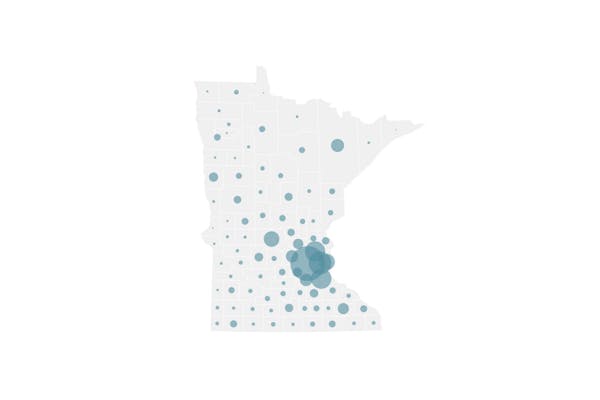COVID-19 rates remained slightly elevated in a handful of Minnesota counties with fewer vaccinations against the infectious disease, according to a weekly state pandemic report released Thursday.
Among the 10 counties with COVID-19 rates of 5 per 10,000 people or higher in the week ending June 5, none had vaccination rates that were above the state average — underscoring Gov. Tim Walz's concern that some regions could be breeding grounds for more infectious variants of the coronavirus that causes COVID-19.
"We still have pockets of relatively low vaccination rates in parts of the state and country," he said last week during a public appearance to promote vaccination. "Those pockets are starting to see an increase in some of those variants that showed up in India and some of those places."
Overall, pandemic activity has dropped to the lowest levels in months in Minnesota, which had the 24th lowest new infection rate among states for the week ending June 10, after having one of the nation's highest rates for most of the spring.
Minnesota reported four COVID-19 deaths Thursday and 142 infections. Those numbers raised the state's totals in the pandemic to 7,527 deaths and 604,184 known infections, but reflected a decline in pandemic activity. The positivity rate of diagnostic testing has fallen to 1.8%.
More than 80% of new infections in Minnesota are linked to variants of concern — with genomic sequencing of a sampling of positive cases identifying 16,054 infections with the alpha variant first identified in England. (Health officials recently have changed terminology in describing variants such as alpha, also known as B.1.1.7.)
State sequencing also has identified 360 infections linked to the gamma variant first identified in Brazil and 43 infections involving the delta variant that fueled a recent nationwide outbreak in India and was upgraded to a "variant of concern" by U.S. health authorities this week. Hospitalization rates have been higher in cases involving the gamma and delta variants.
Whether low vaccination levels cause elevated county infection rates in Minnesota is unclear. Only a few studies so far have examined the link.
Nference, a data analysis partner to Mayo Clinic, reported in March that U.S. counties with higher initial vaccination rates tended to have lower infection rates. However, the study found so many confounding variables — from varying mask-wearing levels to population densities — that it concluded infection and vaccination rates were independent variables.
"In general, counties with more vaccination rates display lower incidence of COVID-19 cases," said Venky Soundararajan, nference's co-founder and chief scientific officer.
The organization on Thursday re-examined COVID-19 data in Minnesota and found only two small counties — Kittson and Marshall — that had higher weekly infection numbers in mid-June compared with mid-May. Soundararajan said that suggests that vaccination is paying off.
A Star Tribune analysis showed a trend through April and early May of Minnesota counties with lower vaccination rates having higher weekly infection rates. Sherburne and Isanti counties, for example, had the highest rates of new infections on April 15 when they had some of the lowest rates of people who were fully vaccinated — meaning it had been 14 days since they had received their final dose. Cook County had the highest vaccination rate and lowest infection rate.
There were exceptions, though, with Mille Lacs and Jackson counties having high infection rates despite average vaccination progress.
State health officials said it is difficult to prove that local vaccination rates influence infection levels in the middle of a pandemic when other factors are at work. Prior infection levels can have a substantial impact on current COVID-19 rates. People are assumed to at least have 90 days of immunity after prior coronavirus infections, so a county with a large outbreak months earlier would have lower case rates — regardless of vaccinations.
Mask-wearing and social distancing levels can have an impact along with testing levels, which can uncover more asymptomatic infections, said Kumi Smith, an assistant professor of epidemiology and community health at the University of Minnesota.
"It's possible [these other factors] are going to be obscuring that true effect that may be there," she said.
Other data have demonstrated vaccine effectiveness. Duluth-based St. Luke's has been part of a national group showing reduced infection rates and severe COVID-19 illnesses among health care providers and first responders who have been vaccinated.
In Minnesota, infection rates and COVID-19 deaths have declined among the elderly who were prioritized for vaccine in the winter. Infections among pre-K-12 educators also didn't increase this spring, even as infections surged among students.
More than 3 million eligible people 12 or older have received at least a first dose of COVID-19 vaccine in Minnesota — with 66% of people 16 or older receiving at least a first dose and the state nearing its goal of 70% by July 1.
Gaps or low vaccination rates at the local level are causes of outbreaks of other infectious diseases such as measles and pertussis, said Kris Ehresmann, state infectious disease director. As COVID-19 levels continue to decline, such isolated outbreaks could begin to emerge as well in communities with less vaccination coverage.
"We do worry that as things related to COVID-19 stabilize we will see the same risk for unvaccinated areas as we see with other" vaccine-preventable diseases, she said. "That is, lower vaccination puts a community at risk for disease."
News developer Michael Corey contributed to this report.
Jeremy Olson • 612-673-7744
8 months in jail for Blaine man who caused 120-mph crash hours after he was caught speeding

Daughter sues St. Paul, two officers in Yia Xiong's killing

